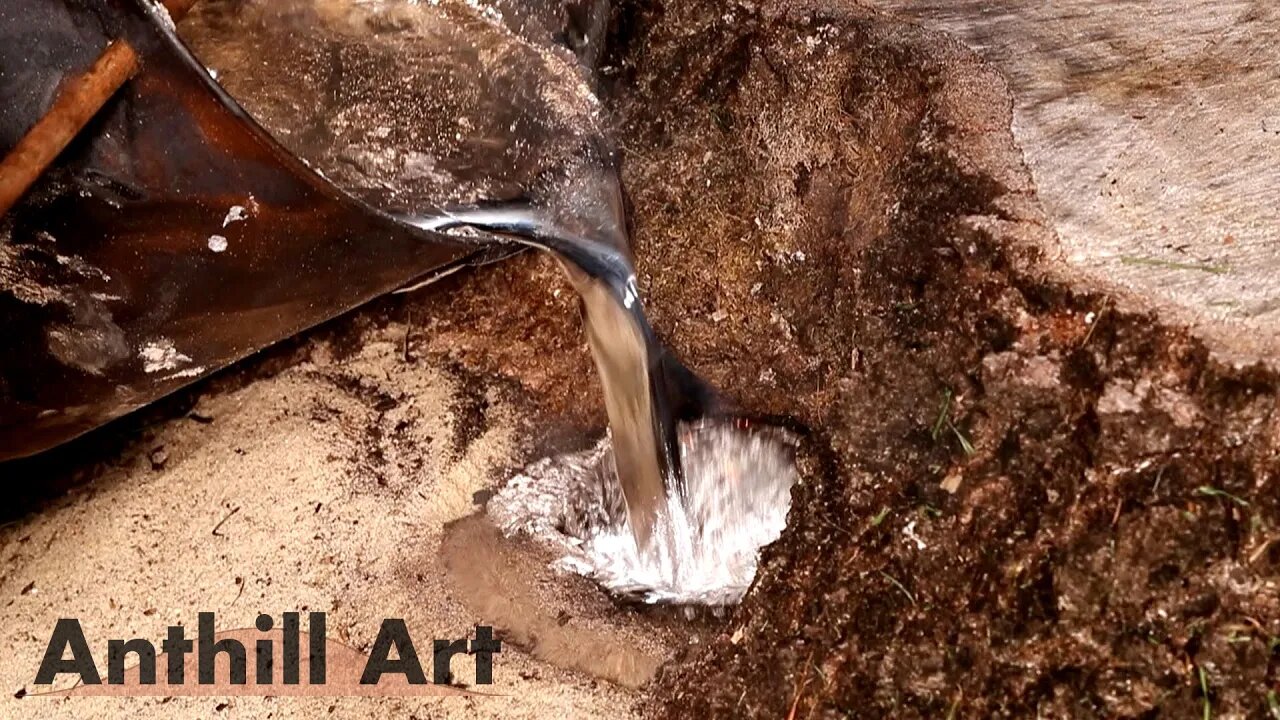Premium Only Content

Craziest Cast Yet! – Casting an Ant Colony in a Stump with Molten Aluminum (Cast #121)
This is the possibly the craziest cast I’ve ever attempted and definitely the most challenging. This is a field ant colony (species Formica pallidefulva) with a single entrance tunnel right up against a large oak stump. Around 22 lb of aluminum was melted and it ended up taking around 10 lb to fill the colony. I didn’t know how exactly how to go about getting the cast out but I knew 1) I can cut wood and 2) I can dig dirt. So, how hard can it be? Turns out, it can be really hard.
I started to dig and cut initially, before deciding that doing that was going to be too difficult. Then I tried burning for two days and that seemed way too slow. I was posting my progress to my Facebook page (https://www.facebook.com/anthillart), and someone suggested drilling holes to make vents in the wood to target certain pieces, which I tried. Then it occurred to me that if I drilled into a section of wood from two angles, I could be fairly sure I wasn’t cutting into the cast if I cut down the line of the drill holes. These ants don’t tunnel in wood and the colony is only in the dirt pockets, so if I’m drilling and I hit dirt then I know not to cut to that depth. I don’t show the drilling much in the video but I’m doing that before most cuts. That’s why you see so many holes in the wood.
I actually didn’t plan on keeping the cast in the wood until the very end, which is why I wasn’t worrying too much about the damage I was doing to it. All for the better though because it would have taken much longer and probably wouldn’t have turned out as cool if I had planned to keep it in the wood. Toward the end, when I’m cutting on the back side of the cast, I still didn’t know if there would be a piece of cast sticking out on that side, once I saw that it was all contained well within the wood, I decided to keep it in the wood.
The cast has two main sections: the piece that comes out of the front and a more hidden piece that runs straight down in a vertical void in the wood. I only discovered that second piece after washing it.
It took ten days from the pour for the cast to be removed from the ground, around 40 hours worth of work. Some of that time was setting up cameras and even more of it was me scratching my head though.
Figuring out the mounting was a major task for me. I settled on drilling 3/4” holes on three sides of the wood and inserting oak dowels, as close to horizontal as I could. Then I built the base so that it catches those oak dowels and the cast can sit upright and be stable.
The colony is around 20” deep and the weight of the aluminum is around 10 lb. The total weight of the wood and the cast was 38 lb last I checked (it’s still drying and getting lighter).
I wasn’t quite sure to what extent I should clean up the wood but I sanded it a little bit and tried to remove any splinters. I started to plug some of the holes but didn’t like how that was working so I just left them. I may do more work on it as it dries. I’m not too sure what’s going to happen as the wood dries and splits but I used Pentacryl to help preserve the wood and have taken other measures. We’ll see!
More pics of the cast at: https://www.anthillart.com/castings/121/
-
 LIVE
LIVE
Side Scrollers Podcast
2 hours ago4Chan SUES UK Government + Craig Has Mental Illness Fatigue + Knight Rider REBOOT | Side Scrollers
349 watching -
 1:17:10
1:17:10
Sean Unpaved
2 hours agoColt Knost Unplugged: Golf, 2025 Ryder Cup, & Football Fever
12.3K -
 DVR
DVR
Neil McCoy-Ward
1 hour agoIt’s About To Get Ugly Between JD Vance and Macron
4.94K1 -
 LIVE
LIVE
Total Horse Channel
18 hours ago2025 Gypsy Congress Championship Show | Thursday
482 watching -
 LIVE
LIVE
TheAlecLaceShow
1 hour agoJacob Frey MOCKS Catholics | Annunciation | Guests: Gordon Chang, Jim Pfaff | The Alec Lace Show
88 watching -
 LIVE
LIVE
Viss
2 hours ago🔴LIVE - Stacking Wins is What We Do! - PUBG Tactics 101
113 watching -
 LIVE
LIVE
Law&Crime
5 hours ago $1.63 earnedLIVE: Adelson Matriarch Murder Trial — FL v. Donna Adelson — Day 5
428 watching -
 LIVE
LIVE
The Mel K Show
1 hour agoMORNINGS WITH MEL K - Refusing the Lie & Standing Firmly for Truth 8-28-25
690 watching -
 LIVE
LIVE
The Shannon Joy Show
3 hours ago🔥🔥BREAKING: FOIA’d Government Docs Reveal American Citizens Might Be Worth More DEAD Than Alive. Exclusive With Sasha Latypova! 🔥🔥
236 watching -
 1:00:16
1:00:16
Trumpet Daily
1 hour ago $1.08 earnedTrumpet Daily LIVE | Aug. 28, 2025
10.1K2